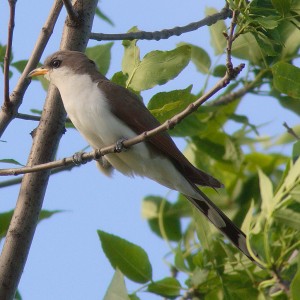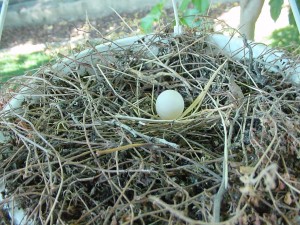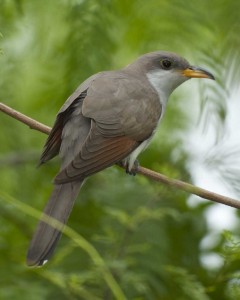Content for this page researched and created by Katrina Long
Yellow-Billed Cuckoo (Cozzycus americanus)
The yellow billed cuckoo (Cozzycus americanus) is a noisy bird that spends a lot of time out and about on cloudy, and rainy days, which has earned it the nickname the “Rain Crow” (Audubon Bird Web). It is a medium sized bird typically with brown feathers, but feather colors differ with age and gender (Avian Web). It lives anywhere in the U.S., southern Canada and Northern Mexico (Animal Diversity Web). The western birds are slightly larger than those in the east, and this is causing issues in the taxonomy of the species. It has been suggested that these western and eastern forms of the cuckoo are distinct subspecies, but no other fundamental differences have been found. (National Geographic)
gender (Avian Web). It lives anywhere in the U.S., southern Canada and Northern Mexico (Animal Diversity Web). The western birds are slightly larger than those in the east, and this is causing issues in the taxonomy of the species. It has been suggested that these western and eastern forms of the cuckoo are distinct subspecies, but no other fundamental differences have been found. (National Geographic)
Differences in coloration of cuckoos include variations in the black and white patterns under the bird’s iconic long tail. Most cuckoos will have brown feathers on their backs and heads and yellow beaks. They will also have bright yellow rings around their eyes and a cinnamon color in the wings when in flight. Juveniles are very similar but have gray in the tail instead of black (Avian Web).
The birds are quite noisy, their calls include: “ka ka ka ka ka kow kow kow” (Avian Web). And a “Kowp kowp kowp” (Percevia). The females are usually larger than the males, but they incubate their eggs equally (Cornell Lab). The female does however take on a lot of the usually male responsibilities. This could possibly be because of the reverse dimorphism (Ethology).
The cuckoo is a member of the family Cuculidae and order Cuculiformes. The family has about 128 members, and they all share the common feature of a zygodactyl foot. Which is when two toes point forwards and two toes point backwards (USFWS).
A group of Cuckoos is known as either a “Cooch,” or an “Asylum” (Percevia). Within a cooch, the birds have interesting breeding tendencies. The transition from egg to fledgling take as little as 19 days (Ebird). Within two hours of hatching, the young are fully feathered (Percevia). On average, the Cuckoo lays 1-5 eggs per clutch, but that number can go higher when insect populations are elevated (Audubon Guide to North American Birds). Cuckoos don’t lay their eggs all at once, and the time between one egg to the next can be as long as five days. This means that the oldest chick can be close to leaving the nest when the youngest is just hatching. This is called asynchronous egg laying (Cornell Lab).
Cuckoos lay both white and blue eggs, and scientists such as Lorenzana have hypothesized that the reason these different egg colors evolved is so that the eggs would blend in with the eggs that are laid by the species that they parasitize (The Auk) . Yellow-billed Cuckoos, unlike Old World cuckoo species, only occasionally lay eggs in the nest of other birds. Mostly this nest parasitic behavior occurs during times of super-abundant food supplies (The Wilson Bulletin). Birds commonly parasitized, though, are species that are of similar size, such as the American Robin (Ebird). But the egg color hypothesis seemed to fail in a study that showed only 5 out of 15 cuckoos laid blue eggs in robin nests (The Auk). The more eggs that a cuckoo lays, the more likely they are to engage in nest parasitism (The Wilson Bulletin).
Reproductive behaviors in cuckoos are affected by their diets (Ebird). In 1985 there was a major increase in the clutch size of New World cuckoos which was hypothesized to be caused by superabundant available food sources (The Wilson Bulletin). The mass 17-year cicada emergence in 1981 led to an abundance of cuckoo eggs in the nests of many different species of birds (The Wilson Bulletin). When food sources begin to get scarce, though, the males will cull their clutches usually by removing the youngest bird from their nests (Cornell Lab).
Yellow billed cuckoos are one of the only species to eat hairy caterpillars. They can eat up to 100 hairy caterpillars in one sitting (Cornell Lab). Their food includes about 65% insects (Ethology), hairy caterpillars, tent worms, grasshoppers, katydids, beetles, and some larger individuals may eat small frogs, lizards, and eggs (Audubon Guide to North American Birds).
The populations of Cuckoos are affected by different variables in different locations. For example, Cuckoos in the western U.S. often depend on the availability of their preferred nesting habitats, while the birds in the east depend mostly on the availability of food (Audubon Guide to North American Birds). In the east significant rises in cuckoo numbers have been correlated with Gypsy Moth outbreaks and Cicada emergences (Ebird). . Hunting tactics vary with habitat and environment, but often cuckoos find a perch and wait for prey to come into sight. They rely on their coloration and stillness for camouflage. Upon sighting a prey item, they then swoop out of hiding and snatch it off the ground or out of the air (Audubon Bird Web).
The Yellow Billed Cuckoo is “Neotropical,” meaning that they live in temperate zones but winter in the tropics. It breeds and lives throughout the eastern and western U.S., in south eastern Canada, and in northern Mexico (Audubon Bird Web). Habitats in which they occur must fit their needs (Animal Diversity Web). For example, they can live in cottonwood willow riparian (near water) habitats but the vegetational structure must conform to their hunting needs (Laymon).
Populations of the Yellow Billed cuckoo are in serious s danger. The birds are listed as threatened in CA, CO, AR, MT, ID, NM, NV, OR, TX, UT, WA, and WY (ECOS). The population change in the west is being caused by loss of habitat. The human population has grown, resulting in loss of riparian habitats because of dam building, agriculture, and increased development. Over the last 300 years, the riparian habitat has declined from 5% of the landmass to only 1% (Northern University of Arizona). Climate change is another factor in habitat loss. In 2007 a major drought in Colorado dropped the water in Lake Mead by fifteen feet (Northern University of Arizona). From 2006 to 2007, most of the trees that the cuckoo lived in were dead or dying due to the drought. Where cuckoos had been found 2006 they no longer occurred in 2007. Warmer water and air temperatures are also hurting the insects and reptiles that the birds commonly eat (PLoS One). It has been hypothesized that the best place for the birds to go would be into higher elevations to be in the cooler water and air temperatures (PLoS One).
s danger. The birds are listed as threatened in CA, CO, AR, MT, ID, NM, NV, OR, TX, UT, WA, and WY (ECOS). The population change in the west is being caused by loss of habitat. The human population has grown, resulting in loss of riparian habitats because of dam building, agriculture, and increased development. Over the last 300 years, the riparian habitat has declined from 5% of the landmass to only 1% (Northern University of Arizona). Climate change is another factor in habitat loss. In 2007 a major drought in Colorado dropped the water in Lake Mead by fifteen feet (Northern University of Arizona). From 2006 to 2007, most of the trees that the cuckoo lived in were dead or dying due to the drought. Where cuckoos had been found 2006 they no longer occurred in 2007. Warmer water and air temperatures are also hurting the insects and reptiles that the birds commonly eat (PLoS One). It has been hypothesized that the best place for the birds to go would be into higher elevations to be in the cooler water and air temperatures (PLoS One).
Habitat loss is also causing problems in nesting. Yellow-billed cuckoos typically nest soon after arrival in their norther breeding regions in the spring, but if food sources are limiting, they may delay breeding for up to a month. This delay in nesting is causing the numbers of breeding pairs to decline all over the west (Laymon). Breeding is limited to the Sacramento River from Red Bluff to Colusa, the South Fork of the Kern River from Isabella Reservoir to Canebrake Ecological Reserve. However numbers fluctuate from year to year based on the environment (California partners in Flight Riparian Bird Conservation Plan). For example, from 1990-1992 the amount of breeding pairs increased from two, to twenty four in the south fork area of the Kern River (Laymon). In Arizona, pairs are not even widely scattered. Eighty five percent of cuckoos in Arizona are found in the Bill Williams River National Wildlife Refuge, this leads researchers to believe that the best place for western cuckoos is in national wildlife refuges where their habitats cannot be destroyed (Northern University of Arizona). Changes are being made to save the species.
There are multiple HCP’s (Habitat Conservation Plans) in place to save the Yellow Billed Cuckoo in the West (ECOS). The USFWS set out recommended conservation measures that included locating the current pairs, and then improving the riparian habitats around them. It also suggested that the wintering habitats be investigated to determine if stresses there are affecting cuckoo numbers.The incidence (and potential) of nest parasitism is also a potential area of study (USFWS).
As stated before, there are many conservation groups that are pushing for the subspecies to be named. There are many arguments against it though. In 2006, 2490 base pairs of the mitochondrial genes cytochrome oxidase II and III, and cytochrome b were used in order to reevaluate the genus and conclude the phylogeny of the different species. Two new species were named but Hughes found no fundamental difference between the eastern and western yellow billed cuckoo, to be able to name a subspecies (Systematics and Biodiversity). The reasoning for the argument in naming a subspecies for C. americanus is based on research where a slight but significant divergence was found in a single mitochondrial DNA (Ardea). The research was replicated with a larger number of the same base pairs and no significant divergence was
 found. It was concluded that the divergence, if any would likely be too recent to be found in any single mitochondrial DNA (Systematics and Biodiversity). However, there was a substantial amount of haplotype variation in the western sample (Ardea).
found. It was concluded that the divergence, if any would likely be too recent to be found in any single mitochondrial DNA (Systematics and Biodiversity). However, there was a substantial amount of haplotype variation in the western sample (Ardea).
If there was a genetic divergence, it likely would have been found in the 2006 study by Hughes when they tested the entire Cuckoo Phylogeny. This study actually reestablished two old genera. This reevaluation concluded that the resurrection of the genus “piata” was needed in order to house two species of cuckoo, the ash colored cuckoo, and the dwarf cuckoo (Systematics and Biodiversity). Other studies also took place that argue against the existence of the subspecies. In 1887, the western species and the eastern species were separated into two separate subspecies, however in the 1980s, Dr. Banks, a bird taxonomist studied 700 birds, and found no significant difference in bill size, wing length, or body color, and then determined that there were no biological differences, and that there was no substantial evidence to declare them two separate species. It was later found that these measurements were faulty. When Banks agreed that the measurements were significantly different, he said that they were not significant enough to allow a subspecies. More recently, multivariate statistics studies have concluded that 89.6% of eastern and 85.8% of western females can be correctly separated into the subspecies. Despite this, it is still being discussed in the scientific community on whether the eastern and western birds are truly different (USFWS).
Works Cited:
General Bibliographies:
Gross, Doug. “Those Crazy Cuckoos Are Back!” EBird. PA Game Commision, 30 June 2015. 21 Sept. 2016. http://ebird.org/content/pa/news/those-crazy-cuckoos-are-back/
Hilt, By Megan. “Coccyzus Americanus (yellow-billed Cuckoo).” Animal Diversity Web. University of Michigan, n.d. 21 Sept. 2016. http://animaldiversity.org/accounts/Coccyzus-americanus/
Laymon, S. A. “Yellow-billed Cuckoo (Coccycus Americanus).” Yellow-billed Cuckoo (Coccycus Americanus). California Partners in Flight Riparian Bird Conservation Plan, n.d. 21 Sept. 2016 https://www.prbo.org/calpif/htmldocs/species/riparian/yellow- billed_cuckoo.htm
“Species Profile for the Yellow-Billed Cuckoo (Coccyzus Americanus).”ECOS Environmental Conservation Online System. USFWS, n.d. 21 Sept. 2016. http://ecos.fws.gov/ecp0/profile/speciesProfile?spcode=B06R
“Yellow-billed Cuckoos.” Beauty of Birds.com. Avian Web, n.d. 21 Sept. 2016 https://www.beautyofbirds.com/yellowbilledcuckoos.html
“Yellow-billed Cuckoo.” BirdWeb. Seattle Audobon Society, n.d. 21 Sept. 2016 http://birdweb.org/birdweb/bird/yellow-billed_cuckoo
“Yellow-Billed Cuckoos.” Field Guide to Birds of North America. Percevia, n.d. 21 Sept. 2016. https://identify.whatbird.com/obj/308/_/Yellow-billed_Cuckoo.aspx
“Yellow-billed Cuckoo.” Guide to North American Birds. Audubon, n.d. 21 Sept. 2016. http://www.audubon.org/field-guide/bird/yellow-billed-cuckoo
“Yellow-billed Cuckoo.” Identification, All About Birds. Cornell Lab of Ornithology, n.d. 21 Sept. 2016. https://www.allaboutbirds.org/guide/Yellow-billed_Cuckoo/id
“Yellow-Billed Cuckoos.” National Geographic. National Geographic, n.d. 21 Sept. 2016. http://animals.nationalgeographic.com/animals/birding/yellow-billed-cuckoo/
Scientific Bibliographies:
Farrell, Lindsay L. “Examining the Genetic Distinctiveness of the Western Subspecies of Yellow-Billed Cuckoo Coccyzus Americanus Occidentalis.”ARDEA: vol. 101 no. 2 2013: pp 165-170 BioOne, 21 Sept. 2016. http://dx.doi.org/10.5253/078.101.0211
Fleischer, Robert C., Michael Murphy T., and Lawrence Hunt E. “Clutch Size Increase and Intraspecific Brood Parasitism in the Yellow-Billed Cuckoo.” The Wilson Bulletin vol. 97 no. 1 1985: pp. 125-27. Pp. 851-54. 21 Sept. 2016.
Friggens, Megan M., and Deborah Finch M. “Implications of Climate Change for Bird Conservation in the Southwestern U.S. under Three Alternative Futures: E0144089.” PLoS One vol. 10 no. 12 2015. 21 Sept. 2016. http://search.proquest.com.ezaccess.libraries.psu.edu/docview/1751482371?pq- origsite=summon&accountid=13158
Hughes, Janice M. “Phylogeny of the Cuckoo Genus Coccyzus (Aves: Cuculidae): A Test of Monophyly.”Systematics and Biodiversity vol. 4 no. 4 2006: pp 483-88. 21 Sept. 2016. https://www-cambridge-org.ezaccess.libraries.psu.edu/core/journals/systematics-and biodiversity/article/phylogeny-of-the-cuckoo-genus-coccyzus-aves-cuculidae-a-test-of- monophyly/3F70B0B71BFF1D57CA7E0E046B2A273F
Johnson, Matthew J., Geological (U.S.) Survey, and Northern University Arizona. Understanding the Habitat Needs of the Declining Western Yellow-billed Cuckoo. Vol. 2009 no. 3091 2009: 21 Sept. 2016. http://pubs.usgs.gov/fs/2009/3091/fs2009-3091.pdf
Laymon, Stephen A. “Yellow Billed Cuckoo.” YELLOW-BILLED CUCKOO(n.d.): 21 Sept. 2016. <http://www.blm.gov/ca/pdfs/cdd_pdfs/Ybcu1.pdf>.
Lorenzana, Janice C., and Spencer Sealy G. “Did Blue Eggs of Black-billed (Coccyzus Erythropthalmus) and Yellow-billed (C. Americanus) Cuckoos Evolve to Counter Host Discrimination?” The Auk vol. 119 no. 3 pp. 208. 21 Sept. 2016. http://www.bioone.org.ezaccess.libraries.psu.edu/doi/abs/10.1642/0004- 8038(2002)119[0851:DBEOBB]2.0.CO;2
Maurer, Golo “Who Cares? Males Provide Most Parental Care in a Monogamous Nesting Cuckoo.” Ethology vol. 114 no. 6 2008: pp 540-47. 21 Sept. 2016. <http://onlinelibrary.wiley.comezaccess.libraries.psu.edu/doi/10.1111/j.14390310.2008.0 1498.x/abstract
Streby, Henry M., and Donald Miles B. “Assessing Ecosystem Restoration Alternatives in Eastern Deciduous Hardwood Forests Using Avian Nest Survival.” The Open Environmental Sciences vol. 4 no. 1 2010: pp 31-40. Open Environmental Sciences. 27 Aug. 2010. 21 Sept. 2016. <http://www.bentham- open.com/contents/pdf/TOENVIRJ/TOENVIRJ-4-31.pdf>.
USFWS. “Coccyzus Americanus.” U.S. FISH AND WILDLIFE SERVICE SPECIES ASSESSMENT AND LISTING PRIORITY ASSIGNMENT FORM Coccyzus americaus. USFWS, 28 Apr. 2011. 21 Sept. 2016 http://www.fs.fed.us/r6/sfpnw/issssp/documents/planning-docs/cp-fws-candidate-bi- coccyzus-americanus-2011-04.pdf
Image Bibliography
Wikimedia. Factumquintus. 29 Oct. 2005. Web. 21 September 2016. https://commons.wikimedia.org/wiki/File:Coccyzus-americanus-001.jpg
Flickr. Yahoo. 2013. Web. 21 Sept. 2016. https://www.flickr.com/photos/repayne/9225205703/in/photolist-f4cAfK-f4cAmB- f4cz5i-hevpiU-f4czK6-eRTGYq-f4cAvi-bPVfSr-dCzFog-cZR7Qq-e4T7Eg-FjSfXu- f4cA3K-f4rQT5-f4rPXm-9SvYUm-cck2p1-ae7d7e-4tSWiE-a7hk6u-abcRJu-dHcMAi-Gcnoix-e3j1qc-oF3ZnB-crmRi3-arQizd-2jrDko-HJ7mtp-p7uj7A-3rAN4g-asUYEL- f4rQ5J-f4rQoY-f4rQeA-bWumtX-czydjC-a7eYjN-eyzP2e-axej71-a7eY55-a7eY91- 4tNTwK-a7c5Rz-caUEBU-8JgjjP-ukfz7p-x2BJzE-a7eXYb-eyCYdA
Flickr. Yahoo. 2006. Web. 21 Sept. 2016 https://www.flickr.com/photos/76929746@N04/11451429495/in/photolist-irVz2z- ae2Ku5-qCrmVg-nQTMJj-ovkwET-nHaoX3-9TV4kb-jNGFt-6PLhmT-otqBPy-gz3bQu- 4YQ6cW-5sqmoY-pKdeXx-6Gv63p-HTk1KY-4f2gpG-8dyXtT-k6drC-obYrFu-orkSAw-6hDaJW-nBWt6f-4zFWdT-nieyx9-51F26W-p9sfLP-74QgJv-4w8ELs-apbAik- fiAqwj-irVQkj-5qreWd-ciKek-7pBUQa-pncpbz-7pFQw7-EMJ7i-q6j5vf-fzX7U7- 7pBUnM-rmb8Au-5tkb56-8dCdh5-9QjFod-64YAmE-5sqmph-a15ju-4UGrAg-9QjByG